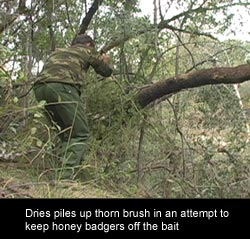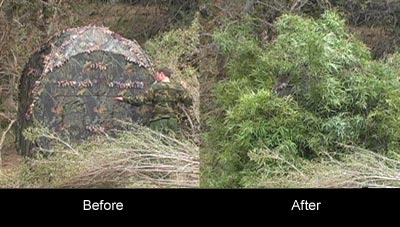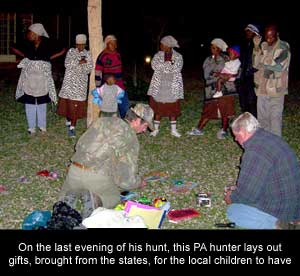Bowsite.com
The Nation's Leading Bowhunting Website
 |
|
|
The first thing we did after breakfast was head out to check on the bait we set out yesterday. It was an hour drive and when we got there it was immediately clear: the bait was hit! Dries and Ben immediately looked at the soft ground for clues to 1. whether it was a leopard and 2. If yes, then how big was it? By the obvious track in the soft sand it was a leopard. But the track was approaching 2" - so it was either a female or a young male. The bait was not quite finished so there was no need to put fresh bait out. Dries brushed the ground clean so we'd see new tracks tomorrow if a leopard fed again. We jumped back into the Toyota and headed to another location. I asked Dries how he had come to find these properties and how the "system" worked? Dries explained that leopard prefer to be close to mountains and hills - similar to baboons. Dries, having grown up in these areas, knows the properties where Leopards are prevalent and the landowners who own them. Many of these leopards are "problem" animals that are killing livestock and game. An old leopard, that is on the decline, is especially troublesome as they will find it difficult to hunt wild game and will seek animals that are less likely to escape. This list would not exlude pets, cows and rare, but occasionally - people. When Dries obtains permission on a property, the landowner wants the cat dead. A wounded leopard can complicate the relationship and even lead to Dries losing future opportunities to hunt the property. In addition to the leopard being removed, the landowners typically require a "trophy fee" payment, which Dries pays and that cost is passed on to the hunter. This whole situation of wounding a leopard and the importance of shot placement (eg. proficiency) was evident to me far before I ever stepped foot in Africa. I had spent time looking into leopard hunting, talking with both successful and unsuccessful hunters, and having numerous conversations with Dries. Probably more than any other hunt I've ever been on - my proficiency was paramount - and for these reasons:
To say that there was a fair bit of stress applied to this hunt is an understatement. The only other hunt I've been on where proficiency was such a factor was my Grizzly hunt - and many of you remember what happened there… But all of this stress may be for nothing. You see, even though I was here in South Africa and we were setting up the baits, I still had not obtained my leopard permit. Dries and his father were very confident that the Provincial authorities would issue the permit - but the leopard permit process is not simple, nor is it easy to obtain. In addition, the Province would not issue the permit unless the hunter showed up in person - a rule enacted this year. Tomorrow Dries and I would drive to Pietersburg to meet with the Game authorities and 'hopefully' come back with the permit. Until then, it was baiting only with my bow still back in my room.
The work began. The first step was to create a barrier for Honey Badgers - who could easily reach the bait and mess up our setup. Dries and Ben piled thorn brush at the base of the tree to prevent the badgers from getting to the bait. Ben then hoisted the donkey hindquarter up into the tree and tied it off. The next chore was to setup the blind over on that island. For this setup we needed to use a popup blind instead of the water tank. The water tank, while preferred by Dries for both scent reduction and lack of noise, was too big to carry to this remote spot. It was a long hike from where we parked and the popup was our only option. Once the blind was up, we had to cover it to the point where nothing would recognize it as anything other than a bush.
Time Lapse Video of covering this blind (2.5mb) The entire setup took a few hours before we were satisfied and headed out
of there. One final brush of the That evening, two hunters from PA were leaving. They were thoughtful and
brought toys and gifts from the US for the local children. We had a barbecue
and wished the two hunters a safe flight. While the others continued to enjoy
their evening by the fire, Dries and I headed back for another night of shooting.
But this time my shooting was horrendous. The more I shot, the worse I got.
I could tell Dries was becoming concerned - I mean, there were shots where
I missed the target completely! While attempting to regain my confidence
and save whatever pride I had left - I noticed that the rest on my bow had
lost its spring tension and was laying flat against the shelf. I don't know
how that happened, but it did. We called it a night as I headed back into
the lodge to see if I could repair the rest. Gene Wensel - knowing that it
was a hard decision for me
Needless to say I had a hard time sleeping again. I could feel the pressure I was placing on myself. It was counterproductive and brought back memories of my Grizz hunt. I needed to get this bow fixed, get my proficiency back and prove to myself, and Dries, that I was ready to hunt leopards.
|
 |

 Dries,
Ben and I arrived at the other location to set up a new area. The area Dries
chose was a tree that grew out from a river bank and hung slightly over a
gurgling stream. To the North, and only 15 yards away, stood a little island
in the middle of the stream. I really liked this location for two reasons.
The first was that it provided me with a very close shot - something I prefer
even though I was shooting a very efficient and fast compound. And secondly,
the sound of the stream, as well as the natural "barrier" created
by the river gave us more comfort that we could pull this off undetected.
Dries,
Ben and I arrived at the other location to set up a new area. The area Dries
chose was a tree that grew out from a river bank and hung slightly over a
gurgling stream. To the North, and only 15 yards away, stood a little island
in the middle of the stream. I really liked this location for two reasons.
The first was that it provided me with a very close shot - something I prefer
even though I was shooting a very efficient and fast compound. And secondly,
the sound of the stream, as well as the natural "barrier" created
by the river gave us more comfort that we could pull this off undetected.

 tracks
and tomorrow we'd find out if anything showed up.
tracks
and tomorrow we'd find out if anything showed up. to
shoot a compound on this trip certainly didn't help. His remark went something
like - "you know, I never have that problem with my recurve"…I laughed.
You see, this is one of the reasons that we hard-core traditional guys shoot
simple equipment. It's never the bow… In total fairness to Gene and not to
give anyone the wrong impression - Gene was completely supportive of my decision
to shoot a compound on this trip. It was just too much for him to resist the
light-hearted jab.
to
shoot a compound on this trip certainly didn't help. His remark went something
like - "you know, I never have that problem with my recurve"…I laughed.
You see, this is one of the reasons that we hard-core traditional guys shoot
simple equipment. It's never the bow… In total fairness to Gene and not to
give anyone the wrong impression - Gene was completely supportive of my decision
to shoot a compound on this trip. It was just too much for him to resist the
light-hearted jab.


